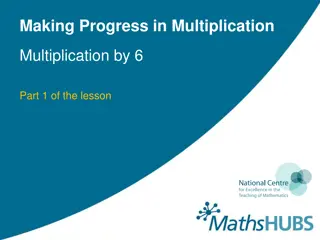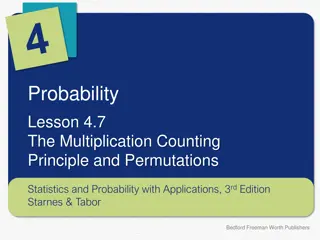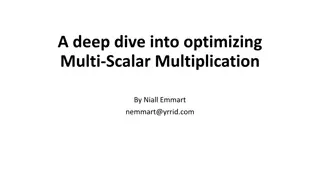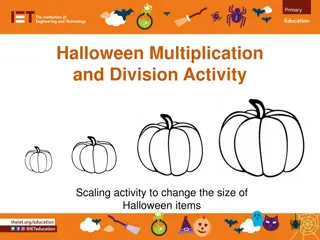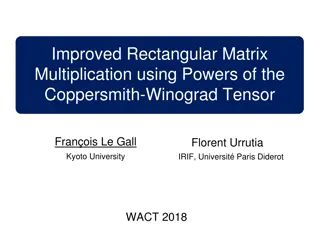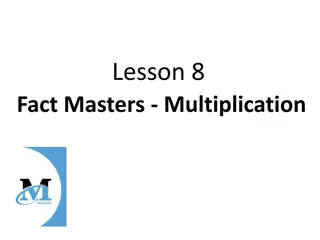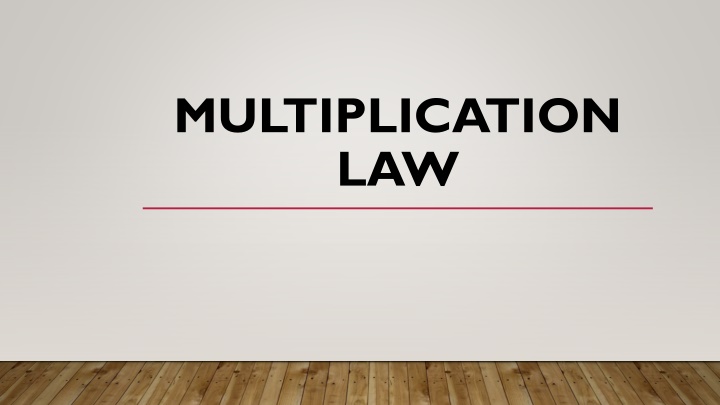
Probability with the Rule of Multiplication
Explore the Rule of Multiplication in probability theory, where the likelihood of two independent events occurring together is determined by multiplying their individual probabilities. Examples illustrate how this rule is applied in various scenarios, enhancing your comprehension of probability concepts.
Download Presentation

Please find below an Image/Link to download the presentation.
The content on the website is provided AS IS for your information and personal use only. It may not be sold, licensed, or shared on other websites without obtaining consent from the author. If you encounter any issues during the download, it is possible that the publisher has removed the file from their server.
You are allowed to download the files provided on this website for personal or commercial use, subject to the condition that they are used lawfully. All files are the property of their respective owners.
The content on the website is provided AS IS for your information and personal use only. It may not be sold, licensed, or shared on other websites without obtaining consent from the author.
E N D
Presentation Transcript
MULTIPLICATION LAW
RULE OF MULTIPLICATION: The multiplication rule (also known as the "AND" rule) states that the probability of two independent events occurring together is equal to the product of their individual probabilities.
Example 4:For example,if you have two events A and B,and the probability of event A occurring is 0.40 and the probability of event B occurring is 0.30, the probability of events A "and" B occurring simultaneously is 0.40 * 0.30 = 0.12. This is because the probability of both events occurring simultaneously is the product of the probabilities of the individual events occurring. Example 5:If you want to calculate the probability of getting a head on the first coin flip and tails on the second coin flip, you will use the rule of multiplication to determine that the probability is 0.25 because the probability of getting heads on the first coin flip is 0.50. The probability of getting tails on the second coin flip is also 0.50, and the probability of both events occurring simultaneously is 0.50 * 0.50 = 0.25.
Example 6: Suppose you have a bag containing 3 red balls and 2 green balls. If you want to find the probability of drawing a red ball (then put this back in the bag: With replacement) and in the second draw you get a green ball,you would use the rule of multiplication: P(redAND green) = P(red) * P(green) = (3/5) * (2/5) = 6/25 = 0.24
Please note that in this example, the probability of drawing a red ball in the first selection does NOT affect the probability of the green ball in the second pick, as the first selection (red ball) is put back in the bag. In this example, the two events were independent events, meaning that one event's occurrence does not affect the probability of the other event occurring.
Example 7: Suppose you have a bag containing 3 red balls and 2 green balls. If you want to find the probability of drawing a red ball and in the second draw you get a green ball (without replacement),you would use the rule of multiplication: P(redAND green) = P(red) * P(green|red) = (3/5) * (2/4) = 6/20 = 0.30 In the above formula,P(green | red) means the probability of getting a Green ball "provided" the first event (getting a Red ball) has already happened.This is called conditional probability. This means that the probability of drawing a red ball and then a green ball without replacement is 0.30,or 30%.
Please note that in this example, the probability of drawing a red ball in the first selection DOES affect the probability of the green ball in the second pick, as the first selection (red ball) is NOT put back in the bag. This reduces the total number of balls in the bag to 4 ( 2 Red and 2 Green) In this example, the two events are dependent events, which means that the occurrence of one event affects the probability of the other event occurring. This rule states that the probability of both events occurring is equal to the probability of the first event occurring multiplied by the probability of the second event occurring, given that the two events are independent.
SUMMARY: The rule of addition for mutually exclusive events: P(A or B) = P(A) + P(B) The rule of addition for non-mutually exclusive events: P(A or B) = P(A) + P(B) - P(A and B) The rule of multiplication for dependent events: P(A and B) = P(A) * P(B/A) The rule of multiplication for non-dependent events: P(A and B) = P(A) * P(B)





